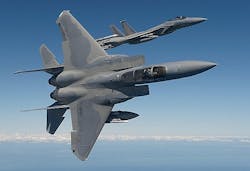Boeing to build 36 new F-15QA combat aircraft with digital fly by wire for Qatar in $6.2 billion deal
Officials of the U.S. Air Force Life Cycle Management Center at Wright-Patterson Air Force Base, Ohio, are asking the Boeing Defense, Space & Security segment in St. Louis to build 36 new F-15QA combat aircraft for the Qatar Emiri Air Force under the Foreign Military Sales (FMS) program.
This order is a part of an estimated $21.1 billion sale of 72 F-15QA aircraft to Qatar, which the U.S. government approved in late 2016. This sale includes aircraft, weapons, training, and ground support. The F-15QA aircraft will join Qatar's combat aircraft fleet, which has the Dassault Mirage 2000 and Eurofighter Typhoon jet fighters.
The F-15QA, a version of the Boeing F-15 Advanced Eagle, is identical to the F-15SA that Boeing is building for the Royal Saudi Air Force. It has a fly-by-wire flight control system, digital electronic warfare (EW) suite, an infrared search and track (IRST) system, and the Raytheon APG-63(v)3 active electronically scanned array (AESA) radar.
The F-15 twin-engine, all-weather tactical jet fighter began development in 1967, and entered service with the U.S. Air Force in 1976.
The Advanced Eagle has 11 underwing weapons stations; the option of a large area display cockpit; fly-by-wire controls; the Raytheon AN/APG-82(V)1 or AN/APG-63(V)3 active electronically scanned array (AESA) radar; General Electric GE F-110-129 engines; digital Joint Helmet - Mounted Cueing Systems in both cockpits; and a digital electronic warfare system among other enhancements.
In a typical escort configuration, the Advanced Eagle can carry 16 AIM-120 Advanced Medium-Range Air-to-Air Missiles (AMRAAMs); four AIM-9X Sidewinder short-range missiles; and two High-Speed Anti-Radiation Missiles (HARMs). For precision strike it can carry 16 Small-Diameter Bombs (SDBs); four AMRAAMs; one 2,000-pound Joint Direct Attack Munition (JDAM); two HARMs; and two drop tanks.
The F-15QA has a terrain-following radar that enables the pilot to fly at a very low altitude following cues displayed on a heads up display. The targeting pod contains a laser designator and a tracking system with a 10-mile range.
Subcontractors to Boeing on the F-15QA include Astronautics Corp. of America in Arlington Va.; BAE Systems in Arlington, Va.; Elbit Systems of America in Fort Worth, Texas; General Electric Aviation in Cincinnati; Honeywell Aerospace in Phoenix; Lockheed Martin Aeronautics Co. in Fort Worth, Texas; L3 Communications in Arlington, Texas; NAVCOM in Torrance, Calif.; Raytheon in Waltham, Mass.; Rockwell Collins in Cedar Rapids, Iowa; Teledyne Electronic Safety Products in Thousand Oaks, Calif.; and UTC Aerospace Systems in Charlotte, N.C.
On this contract Boeing will build the planes in St. Louis, and should be finished by December 2022. For more information contact Boeing Defense, Space & Security online at www.boeing.com/company/about-bds, or the Air Force Life Cycle Management Center at www.wpafb.af.mil/aflcmc.
Ready to make a purchase? Search the Military & Aerospace Electronics Buyer's Guide for companies, new products, press releases, and videos
